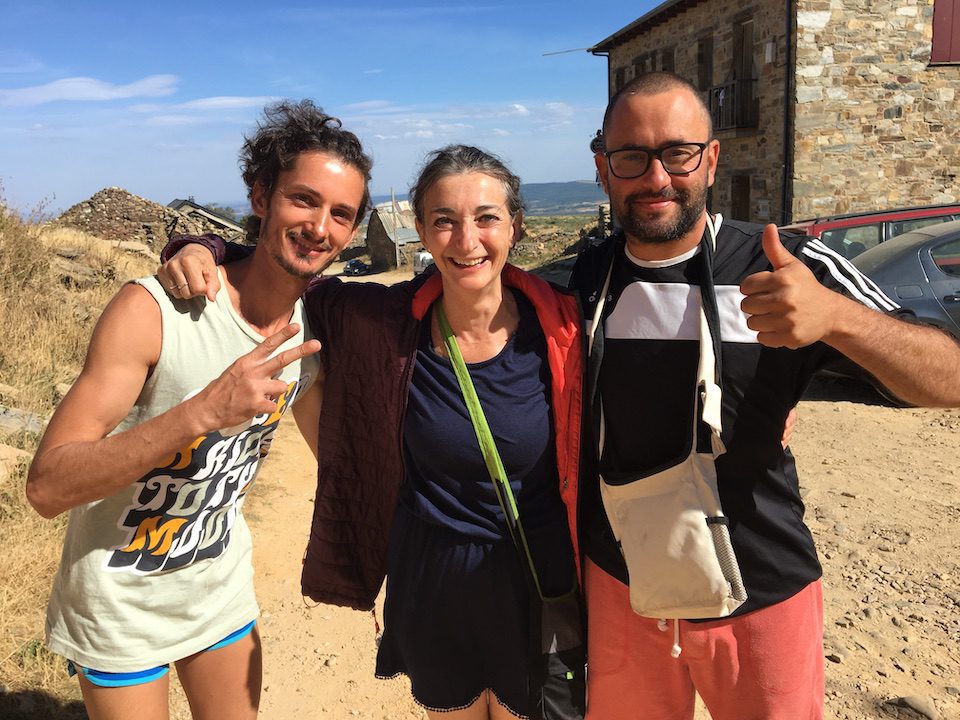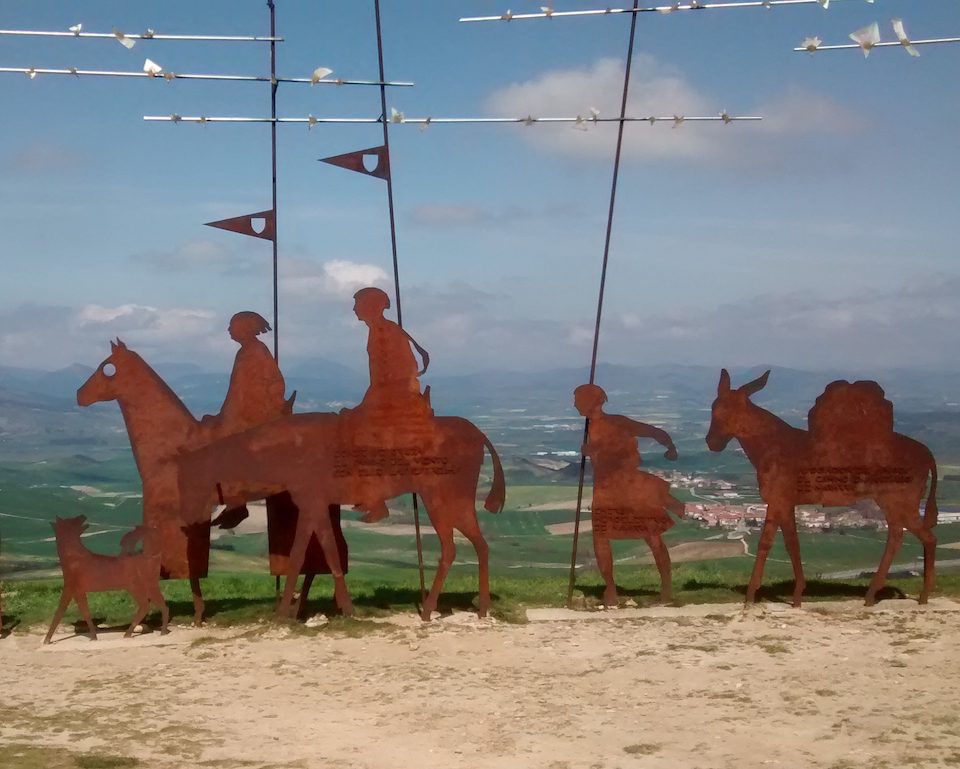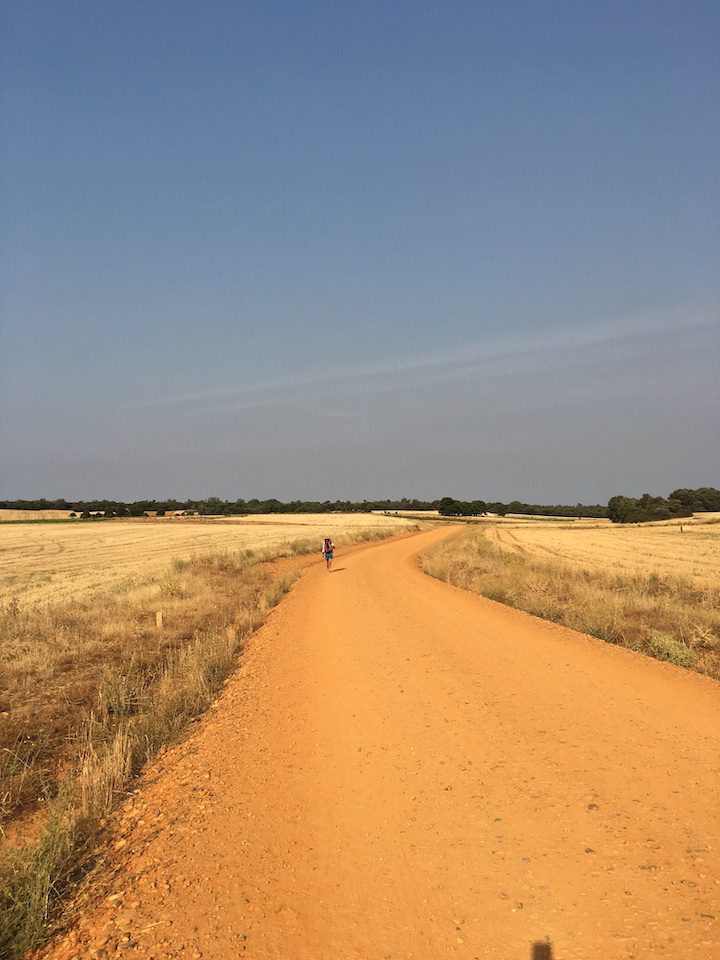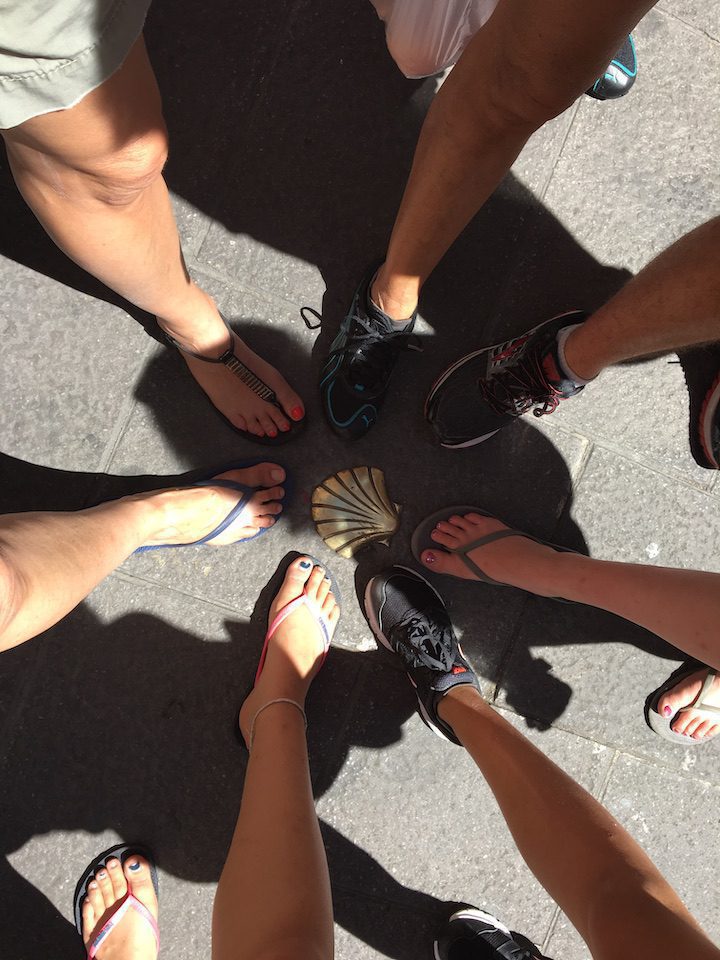Last updated on March 1st, 2024
Featured image: Walking is travel’s slowest form, connecting humans with the earth and themselves | Photo of the Camino provided by Jenna Damore
Where self-discovery meets the healing power of human connection
by Amanda Burgess
By its very nature, a pilgrimage walk reconnects travellers with themselves, nature, and other pilgrims from all cultures and walks of life. One of the world’s most famous walks is the Camino de Santiago – a Catholic pilgrimage that was Medieval Europe’s answer to the thru-hike. In 2020, 53,905 pilgrims (93% Europeans, and 61% ages 30 to 60) received their Compostela (pilgrim certificate), with 92% walking and 8% cycling the Camino’s network of ancient pilgrim routes that stretch across Europe and join at the tomb of St. James in Santiago de Compostela in north-west Spain.
In a series of chats with JourneyWomen who have walked various sections of the Camino, one thing became strikingly clear: A journey of weeks or months all boiled down to the micro-moments. Those fleeting moments of connection that flicker through your mind’s eye like a stack of Polaroids. You only get those moments when you slow down enough to notice them as such, and some way or another, the Camino will make sure you do.
Main motivations for walking
While a full 72% of pilgrims cited spiritual reasons as their main motivation for walking the Camino in 2020, those reasons run the gamut, with all on their own unique quest.
“I didn’t have the money to travel, but was always interested in it. I watched a Rick Steves show where they were doing a driving tour along the Camino and I thought ‘man, that sounds like a cool concept.” Later, I met a friend who was section hiking the Camino. As a solo traveller, I was so in. We watched the movie The Way, and I decided that was going to hike the Camino solo for my 40th birthday,” says Jenna Damore, pilgrim and Admin of the Camigas Facebook group. “I’d had all these goals, but I’d set them in my 20s, and all I could see at that point was up to my 40th birthday. I was ticking them off the list, and when I got to about 39, I realized that I’d checked them all off. It was also a celebration of having reached a milestone.”
For Spanish-born American Miriam Kenet, it was about bonding with her teenage children, a friend and her daughter. “It was something I’d wanted to do for a long time. I felt the need to be in the moment, and I had the time – it’s a time commitment,” she says. “I wanted to see if my children would join me before they were too old to want to do anything with their parents. I actually had very low expectations that they would do it, but they did, and it was amazing.”

Miryam (centre) with friends she met along the Camino
Erin Rochelow, a Canadian now living in the UK, travelled to Spain for the first time back in 1986. Over the years, as she returned to Spain, she’d inevitably hear about the Camino from someone. It got to the point that every time she opened a magazine or saw a travel show, it seemed someone was walking the Camino. She finally got the message, and made plans to do her own pilgrimage in 2014.
“I think initially, it was for the physical challenge. I love Spain, and I was looking at it as an exercise and gastronomic tour. Any time you go to Spain, it’s let’s eat, drink, and be merry,” she says. “Immediately upon starting, it became clear that it was all about the people you meet. Everybody’s got a story. I did the entire shot in 35 days of hiking, and I’ve been every year since for a week or two, and it’s the people and the stories for me.”

Alto de Perdon (Hill of Forgiveness) outside of Pamplona | Photo provided by Erin Rochelow
It’s all about the people you meet
I’ve spoken to many women about their Camino experiences since I took over as Editor of JourneyWoman two years ago. While everyone’s story is unique, one common thread woven through all of them is the impact of other pilgrims on the experience.
“On the Camino, there are a lot of people out there dealing with a loss – a loved one, a partner, a job, whatever. A lot of people are out there healing, so you get really good at hearing people’s stories – we’re all in this together. The Camino strips you down,” says Rochelow. “People know you by what you’re wearing, the clothes on your back. Nobody knows if you drive a Jag or a 20-year-old beater. Nobody knows what your job is. It doesn’t matter. What matters is if you are a decent human being. I think it really strips things down and shows you that everybody’s equal. I’ve met all kinds of people that I would never meet in real life. I think that’s the coolest part – the random conversations you have with people that wouldn’t be part of your comfort zone.”
The people who impressed Rochelow the most were the octogenarians she encountered – all of whom had seemingly inexhaustible energy and an unmatched zest for life.
“One of the best guys I’ve ever met was an 86-year-old Frenchman. He said to me: ‘Well, my wife and I have been married a long time. Sometimes she gets tired and tells me to go for a walk. I walk to Santiago and home again. It takes me about three months, and then she’s okay. She wants me home again.’ I asked him how many times he’s walked, and he said: ‘Oh, many times.’ He was brilliant. 86 and just out there, motoring along,” says Rochelow. “I met these two elderly ladies from France, one of whom was blind, so they walked together with wine, one holding the other’s arm the whole way while they sang. One foggy morning, while walking across a field, I could hear them but couldn’t see them. It was amazing. I finally caught up to them and realized it was these two ladies, just singing through the fog. It’s those kinds of things that make you go back.”
Damore was floored while staying at a little alberque in the Spanish countryside with a Korean farmer, a man a man from Australia who was hiking with a canister of poppies to scatter in the ocean at the end to commemorate the soldiers that had fought in the Iraq war, some Germans, and a smattering of people from other countries.
“We were sitting around drinking beer, and decided that we were all going to sing a song from each of our countries. The Korean farmer, who had studied Korean Opera, got up and began to sing,” she says. “I’m sitting in this albergue in Spain being serenaded by an opera-singing man and thinking – how did I get so lucky to do this thing?”
Kenet stayed at one alberque with a long communal table for dinner that was run by a Frenchman who knew how to create community. The experience taught her that first impressions don’t always hold true, and people have an amazing capacity to surprise you.
“You had to be there at a certain time and you had to eat whatever you got. He said we were going to go around the table, introduce ourselves, where we are from, our age, and why we were doing the Camino. The stories were great. There was a son and father who were doing the Camino in honour of their mother and wife who had always wanted to and died the previous year. There was a middle-aged Italian woman who had just divorced her husband and wanted to walk the Camino to heal her heart,” she says. “And there was a group of German ladies who no one could understand. They seemed unremarkable. Until days later, when we met them in a small church and they began singing. Their voices were incredibly beautiful. The hair on my arms still comes up a little bit when I think of it. It was very emotional.”
On her third Camino, Rochelow met an Israeli soldier in Burgos who she later discovered was an operative of Mossad, Israel’s national intelligence agency. He introduced her to an eclectic group of people he’d been walking with that included an Irish lawyer and his daughter who was studying to be a diplomat and spoke several languages, an ex-priest who was a substance abuse counsellor, two young guys who were trying to walk off a crack habit, and a German male model.

Camino por Castilla | Photo provided by Miryam Kenet
“One night, the model showed everyone how to model walk. To watch the ex-priest and the Mossad guy trying to do it…it was insane. It’s those kinds of priceless experiences you have when you get a random group of people together,” she says.
Whatever you need, the Camino provides
Every pilgrim has a story about running out of water, forgetting a key item, or wanting to quit when, seemingly out of nowhere, someone will show up and offer exactly what they were looking for.
When Damore began her first Camino, her single-minded goal was to complete the entire route within 30 days, following the Brierley Guide. En route to Pamplona, she stopped to stay at a place fortuitously owned by a pharmacist.
“There’s this saying that the Camino provides – all you have to do is listen. I was so overtired. I couldn’t eat. The pharmacist took one look at me trying to choke down a bowl of cereal, and she said: ‘You’re too tired. You need to rest. Get to Pamplona, and then take two or three days, and you’ll feel fine.’ I had only one night planned in Pamplona, but I took her advice and it was a whole new journey.”

Getting ready for another day of walking | Photo provided by Miryam Kenet
Damore hadn’t internalized the lesson yet, and continued to push on with the Brierley Guide as her pace-setter. The punishing pace put her on the path to another burnout.
“This guy popped up and sat down beside me where I was taking a break. He said: ‘I only hike 15 kilometres every day. No more. That gives me enough time to rest, write, read, and do all the things I’m really here for,’” she says. “I pushed on hiking for two more days, feeling like garbage. I was stumbling through this one town and heard someone call my name. It was the same guy. I told him that I was tired and was going to take a break before trying to get more miles in. He repeated his message: ‘I only hike 15 kilometres a day. No more.’ I thought that I probably needed to listen. So, I stopped in that town, and that’s where I threw my Brierley Guide away.”
There’s a synchronicity to the experience of walking the Camino that these women say they haven’t experienced anywhere else.
“My daughter Lola – she’s prone to accidents. She fell, and this Italian woman came along with Band-Aids and alcohol,” says Tenet. “Every time we would be in a pickle, like running out of water, there was Angela with her water.”
Rochelow say the support and sense of community among fellow pilgrims in unmatched.
“It’s different ever time because you’re different every time, and the people who cross your path are different every day. What you need simply shows up. If you need a Band-Aid, a guy walks by ready to bandage your feet for you. A substance abuse counsellor ends up walking with two kids who were trying to fix themselves. That kind of thing is common out there.”
Life lessons these women walked away with
A pilgrimage walk on the Camino changes you – sometimes in ways you never expected. You might absorb those lessons while you’re walking it, or after you’ve walked away from the experience. Either way, those lessons tend to stick.
Rochelow learned that she’s happiest when she’s on the road, and began reflecting on why before applying it to her life at home.
“When you’re walking the Camino, the only thing you have to worry about is: Where am I going to eat? Where am I going to sleep? How am I going to get my underwear washed? Life gets pretty simple,” says Rochelow. “After my first one, I had this epiphany about all the stuff I had. I sold half of what I own and downsized into a studio flat. I learned that I can live with a lot less than I thought I could. It’s just easier to live when you don’t have a lot of stuff – you can focus on what makes you happy.”
Kenet is a planner. She did reams of research before her trip. She thought she was prepared. In the end, the Camino taught her the power of surrender.
“I learned to not try to control so much. When I started to let go, it changed the experience for me. I was more open, more things happened organically. More people approached me than before when I was Miss Tense. I’m a positive person, but I am also plan everything. I had to let it go,” she says.
Damore agrees that it’s all about slowing down and letting the experience unfold as it will.
“The trick to a Camino is that the less expectations you arrive with, the better off you’ll be. Just let the magic unfold. In the Camigos group, there are the Super Hyper Researchers. They need to have every stage planned out, every stop reserved, and they’re marching towards a schedule,” she says. “As I learned, the joy of the Camino is that if you’re tired, you can go sit on a rock somewhere and look at the beautiful countryside or stop in the next town for a piece of cheese and a cookie. Meet people as they come along. I was literally marching towards the sky to get it all done in 30 days. It took a lot for me to throw away that Brierley Guide. It was hard for me to give up that schedule. But when I did, I actually started to experience the journey in a much different way.”
To the women who would love to walk the Camino but are wondering if they can
Of all the questions Damore receives as an Admin on the Camigas Facebook Group, by far the most common is: “I’m XX years old. Is it even possible for me to do a Camino?”
“The answer is absolutely yest. I’ve personally hiked alongside a 90-year-old woman. You see a lot of older women on the Camino and in Spain hiking in groups. They leave their husbands at home because they don’t want to do it anymore. Not only is it doable, but there are plenty of you out there, so you can enjoy each other’s company,” she says. “The Camino is very safe for women, and the Spanish government have introduced improvements that benefit solo travelling women. There’s a new app called Alert Cops that you can download to your phone before you leave. It’s been translated into several languages. If you get someplace and find yourself in a bad situation or scared, you just open the app, click a button, and police are dispatched to your location.”
Discover More of Spain’s Beauty
Holy Week in Spain: Visiting Seville and Barcelona During Semana Santa
Celebrated since the 16th century, Holy Week in Spain is one of the world’s must-see sights, reminding us about community and faith.
Hotels We’d Travel the World For, Just to Stay Again
Travel around the world with women-recommended places to stay that will take you to boutique hotels, guesthouses, retreats and more!
30 Less-Travelled Places for Women in 2024
For our 30th anniversary, JourneyWoman reveals 30 less-travelled places for women in 2024, according to our writers and travel experts.







Yes, the Camino is special. This article captured the spirit of the walk. I have walked the Camino 3 times, at 65, 70 and 73 years of age. The last time there was a need to adjust my pace, and my mileage, and I gave myself permission to skip a part in order to spend a week in Portugal. It still calls to me. Part of me wants to try a winter’s walk. Who knows. The Camino pull never leaves.